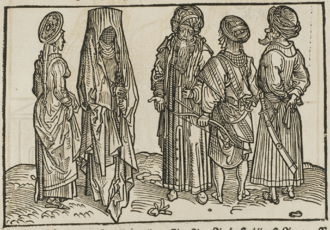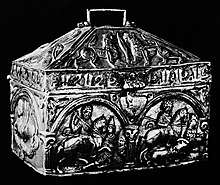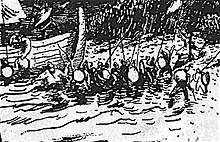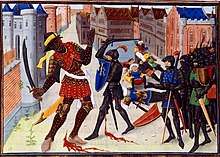Saracen
Saracen were Arab Muslims as referred to by Christian writers in Europe during the Middle Ages. The term's meaning evolved during its history. In the early centuries of the Common Era, Greek and Latin writings used the term to refer to the people who lived in desert areas in and near the Roman province of Arabia Petraea, and in Arabia Deserta.[1][2][3] In Europe during the Early Middle Ages, the term came to be associated with tribes of Arabia.[4] The oldest source mentioning Saracen dates to the 7th century. It was found in Doctrina Jacobi, a commentary that discussed the Muslim conquest of the Levant.[5]

By the 12th century, Saracen had become synonymous with Muslim in Medieval Latin literature. Such expansion in the meaning of the term had begun centuries earlier among the Byzantine Greeks, as evidenced in documents from the 8th century.[1][6][7] In the Western languages before the 16th century, Saracen was commonly used to refer to Muslim Arabs, and the words Muslim and Islam were generally not used (with a few isolated exceptions).[8] The term became gradually obsolete following the Age of Discovery.
Early usage and origins

The Latin term Saraceni is of unknown original meaning. There are claims of it being derived from the Semitic triliteral root šrq "east" and šrkt "tribe, confederation".[9] Another possible Semitic root is srq "to steal, rob, plunder", more specifically from the noun sāriq (Arabic: سارق), pl. sariqīn (سارقين), which means "thief, marauder, plunderer".[10] In his Levantine Diary, covering the years 1699–1740, the Damascene writer Hamad bin Kanan al-Salhi (Arabic: محمد بن كَنّان الصالحي) used the term sarkan to mean "travel on a military mission" from the Near East to parts of Southern Europe which were under Ottoman Empire rule, particularly Cyprus and Rhodes.[11]
Ptolemy's 2nd-century work, Geography, describes Sarakēnḗ (Ancient Greek: Σαρακηνή) as a region in the northern Sinai Peninsula.[2][3] Ptolemy also mentions a people called the Sarakēnoí (Ancient Greek: οἱ Σαρακηνοί) living in the northwestern Arabian Peninsula (near neighbor to the Sinai).[2][3] Eusebius in his Ecclesiastical history narrates an account wherein Pope Dionysius of Alexandria mentions Saracens in a letter while describing the persecution of Christians by the Roman emperor Decius: "Many were, in the Arabian mountain, enslaved by the barbarous 'sarkenoi'."[2][3] The Augustan History also refers to an attack by Saraceni on Pescennius Niger's army in Egypt in 193, but provides little information as to identifying them.[12]
Both Hippolytus of Rome and Uranius mention three distinct peoples in Arabia during the first half of the third century: the Taeni, the Saraceni, and the Arabes.[2][3] The Taeni, later identified with the Arab people called Tayy, were located around Khaybar (an oasis north of Medina) and also in an area stretching up to the Euphrates. The Saraceni were placed north of them.[2][3] These Saracens, located in the northern Hejaz, were described as people with a certain military ability who were opponents of the Roman Empire and who were classified by the Romans as barbarians.[2][3]
The Saracens are described as forming the equites (heavy cavalry) from Phoenicia and Thamud.[13][14][15] In one document, the defeated enemies of Diocletian's campaign in the Syrian Desert are described as Saracens. Other 4th-century military reports make no mention of Arabs, but refer to Saracen groups ranging as far east as Mesopotamia who were involved in battles on both the Sasanian and Roman sides.[13][14][15][16] The Saracens were named in the Roman administrative document Notitia Dignitatum, dating from the time of Theodosius I in the 4th century, as comprising distinctive units in the Roman army. They were distinguished in the document from Arabs.[17]
Medieval usage

No later than the early fifth century, Christian writers began to equate Saracens with Arabs. Saracens were associated with Ishmaelites (descendants of Abraham's older son Ishmael) in some strands of Jewish, Christian, and Islamic genealogical thinking. The writings of Jerome (d. 420) are the earliest known version of the claim that Ishmaelites chose to be called Saracens in order to identify with Abraham's "free" wife Sarah, rather than as Hagarenes, which would have highlighted their association with Abraham's "slave woman" Hagar.[18] This claim was popular during the Middle Ages, but derives more from Paul's allegory in the New Testament letter to the Galatians than from historical data. The name Saracen was not indigenous among the populations so described but was applied to them by Greco-Roman historians based on Greek place names.[2][3]
As the Middle Ages progressed, usage of the term in the Latin West changed, but its connotation remained negative, associated with opponents of Christianity, and its exact definition is unclear.[19] In an 8th-century polemical work, John of Damascus criticized the Saracens as followers of a false prophet and "forerunner[s] to the Antichrist."[20]

By the 12th century, Medieval Europeans used the term Saracen as both an ethnic and religious marker.[1][21] In some Medieval literature, Saracens were equated with Muslims in general and described as dark-skinned, while Christians lighter-skinned. An example is in The King of Tars, a medieval romance.[22][23][24] The Song of Roland, an Old French 11th-century heroic poem, refers to the black skin of Saracens as their only exotic feature.[25]
The term Saracen remained in widespread use in the West as a synonym for "Muslim" until the 18th century. When the Age of Discovery led to it becoming gradually obsolete and referred to Muslims as "Mohammedan" which came into usage from the 1600 onwards. However "Saracen" continued to be used until the 19th century. The Victorian era phrase "Indo-Saracen Architecture" is an example of this.
In the Wiltshire dialect, the meaning of "Sarsen" (Saracen) was eventually extended to refer to anything regarded as non-Christian, whether Muslim or pagan. From that derived the still current term "Sarsen" (a shortening of "Saracen stone"), denoting the kind of stone used by the builders of Stonehenge [26] - long predating Islam and all monotheistic religions.
See also
| Wikisource has the text of the 1911 Encyclopædia Britannica article Saracens. |
- Arab–Byzantine wars
- Early Muslim conquests
- Queen Mavia
- Serkland
Notes
- Daniel 1979, p. 53.
- Retsö 2003, p. 505.
- Retsö 2003, p. 506.
- The Editors of Encyclopaedia Britannica (2012). "Saracen". Britannica Concise Encyclopedia. Cambridge University Press. Archived from the original on 2018. Retrieved 27 April 2012.
- Déroche, Vincent; Dagron, Gilbert (1991). Doctrina Jacobi nuper Baptizati, "Juifs et chrétiens dans l'Orient du VIIe siècle" (Edition of the Greek text with French translation ed.). pp. 17–248.; Kirby, Peter. "External references to Islam". External References to Islam.
- Kahf 1999, p. 181.
- Retsö 2003, p. 96.
- Tolan, John V. (6 July 2002). Saracens: Islam in the Medieval European Imagination. Columbia University Press. p. 15. ISBN 978-0-231-50646-5.
- Toral-Niehoff, Isabel. "Saraca". In Cancik, Hubert; Schneider, Helmuth; Salazar, Christine F.; Orton, David E. (eds.). Brill's New Pauly: Encyclopaedia of the Ancient World. 14. Brill Publishers. p. 1158. doi:10.1163/1574-9347_bnp_e1101160.
- Shahîd, Irfan (1984). Rome and the Arabs: A Prolegomenon to the Study of Byzantium and the Arabs. Dumbarton Oaks. p. 125. ISBN 0884021157.
- "الحوادث اليومية من تاريخ أحد عشر وألف ومية"" [The Chronicles of Ash-Sham"]. Yawmiat Shamiyya (Chronicles of Ash-Sham) (in Arabic). The Daily Events As of 1111 Hijri / 1699 CE. 15 October 2015. Retrieved 30 April 2018.CS1 maint: others (link)
- Retsö 2003, p. 457.
- Retsö 2003, p. 464.
- Retsö 2003, p. 465.
- Retsö 2003, p. 466.
- Retsö 2003, p. 517.
- Retsö 2003, p. 464-466.
- Rubenstein, Jay (1 November 2011). Armies of Heaven: The First Crusade and the Quest for Apocalypse. Basic Books. p. 121. ISBN 0-465-01929-3.
- Daniel 1979, p. 246.
- Damascene, John (28 April 2012). "The Fount of Knowledge" (PDF). Gotiska Ärkestiftet av de Sanna ortodoxt kristna. Translated by Warwick, G. N. Archived from the original (PDF) on 26 September 2013. Retrieved 30 April 2018.
- Heng 2012, p. 334.
- Heng 2012, p. 231.
- Heng 2012, p. 422.
- "The King of Tars". The Crusades Project. University of Rochester. 28 April 2012. Archived from the original on 16 July 2015. Retrieved 30 April 2018.
- Kahf 1999, p. 31.
- Bruce Bedlam The stones of Stonehenge
Bibliography
- Kirby, Peter. "External references to Islam". External References to Islam.
- Déroche, Vincent; Dagron, Gilbert (1991). Doctrina Jacobi nuper Baptizati, "Juifs et chrétiens dans l'Orient du VIIe siècle" (Edition of the Greek text with French translation ed.). pp. 17–248.</ref>
- Daniel, Norman (1979). The Arabs and Mediaeval Europe. Longman. p. 385. ISBN 0-582-78088-8. JSTOR 43628523.CS1 maint: ref=harv (link)
- Heng, Geraldine (19 June 2012). Empire of Magic: Medieval Romance and the Politics of Cultural Fantasy. Columbia University Press. p. 536. ISBN 978-0-231-12527-7. JSTOR 10.7312/heng12526.CS1 maint: ref=harv (link)
- Kahf, Mohja (1999). Western Representations of the Muslim Women: From Termagant to Odalisque. University of Texas Press. p. 207. ISBN 978-0-292-74337-3.CS1 maint: ref=harv (link)
- Retsö, Jan (4 July 2003). The Arabs in Antiquity: Their History from the Assyrians to the Umayyads. Routledge. p. 704. ISBN 978-0-7007-1679-1.CS1 maint: ref=harv (link)
- Timani, Hussam, Saracens, in Muhammad in History, Thought, and Culture: An Encyclopedia of the Prophet of God (2 vols.), Edited by C. Fitzpatrick and A. Walker, Santa Barbara, ABC-CLIO, 2014, Vol. II, pp. 538–542. ISBN 1610691776
- Tolan, John; Veinstein, Gilles and Henry Laurens. 2013. Europe and the Islamic World: A History. Princeton University Press. ISBN 978-0-691-14705-5.
- Tolan, John Victor. 2002. Saracens: Islam in the Medieval European Imagination. Columbia University Press. ISBN 978-0-231-12333-4